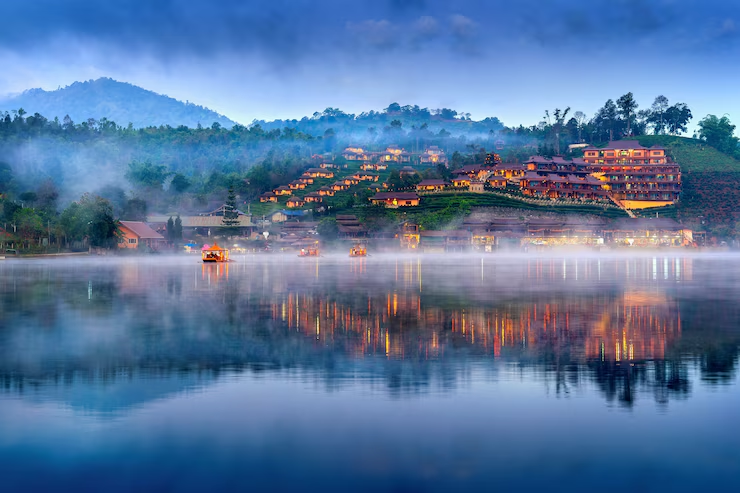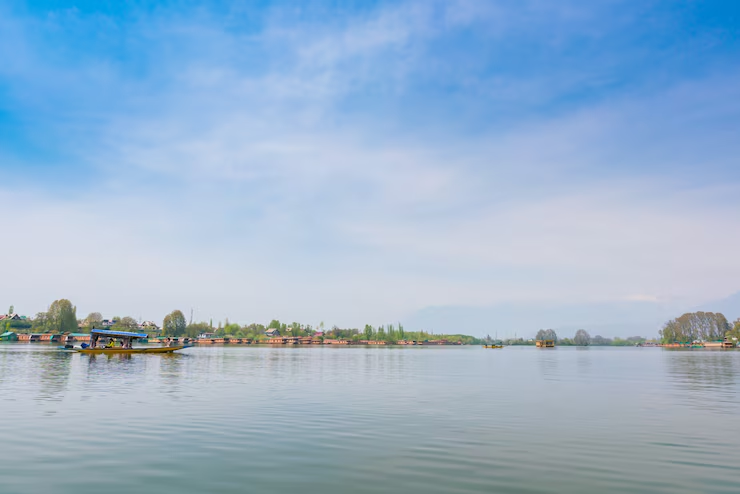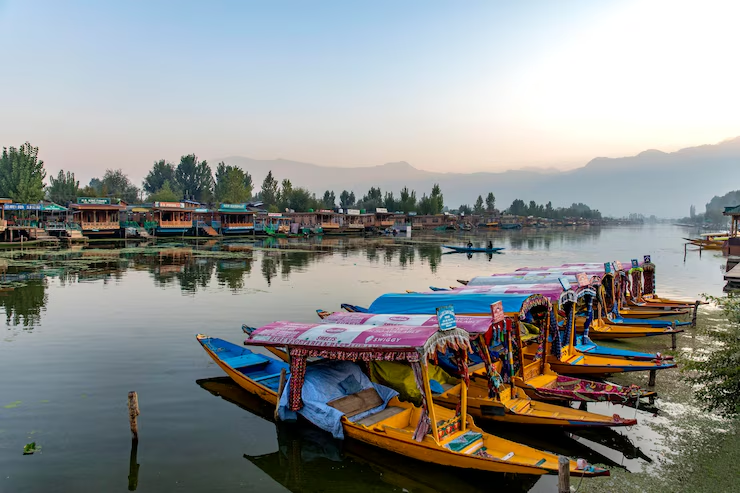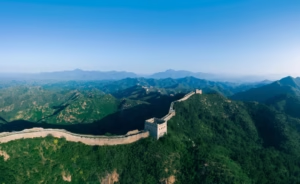Dal Lake: The Jewel of Kashmir, Geography and History

Dal Lake, often called the “Jewel in the crown of Kashmir,” is one of the most famous and beautiful lakes in India. Located in the heart of Srinagar, the capital city of the Union Territory of Jammu and Kashmir, Dal Lake is not just a natural water body but a lifeline and identity of the region. Surrounded by the majestic Himalayas, the lake is famous for its scenic beauty, houseboats, floating gardens, and unique lifestyle of the people living on and around it.
Geography of Dal Lake
Dal Lake is located in the Zabarwan mountain valley, east of Srinagar city in Jammu and Kashmir, India. The lake is approximately 1,583 meters (5,194 feet) above sea level.
Size and Dimensions
- Area: Around 18 square kilometers (though it used to be more in the past).
- Length: About 7.4 kilometers.
- Width: About 3.5 kilometers.
- Depth: Varies from 1.5 to 2.7 meters (in shallow and deep areas).
The lake is divided into four basins: Gagribal, Lokut Dal, Bod Dal, and Nigeen. Nigeen Lake, although often considered a separate lake, is connected to Dal Lake through a narrow strait.
Water Sources
Dal Lake receives water from natural springs, rainfall, and small streams flowing from surrounding hills. The Telbal Nallah is the main inflow stream, while the Dal Lock Gate controls the outflow to the Jhelum River.
Historical Background
Dal Lake has a rich history that dates back several centuries.
Ancient Period
According to historical records, the origin of Dal Lake may go back to the post-glacial period, around 4,000 years ago. It was formed as a result of glacial activity and changes in river courses.
https://sypertimes.com/shimla-the-queen-of-hills-history-and-geography/
Medieval Period
In the Mughal era (16th to 18th century), Dal Lake gained prominence as the Mughals built beautiful gardens, pavilions, and terraces along the lake’s shores. Famous Mughal gardens like Shalimar Bagh, Nishat Bagh, and Chashme Shahi were built during this time and still exist today as major attractions.

British Period
During British rule in India, Dal Lake continued to grow in popularity. The British were not allowed to buy land in Kashmir, so they started living in houseboats on the lake. This gave rise to the unique tradition of living on water that still exists today.
Ecology and Natural Features
Dal Lake is home to a rich ecosystem and supports a wide variety of flora and fauna.
Aquatic Life
- The lake contains several species of fish, including Schizothorax, which is common in Kashmir.
- It supports thousands of migratory birds, especially in winter. Species like Brahminy ducks, herons, and kingfishers are often seen.
Floating Gardens
One of the unique features of Dal Lake is its floating gardens, called “Raad” in Kashmiri. These are artificial islands made of weeds and mud where people grow vegetables like cucumbers, tomatoes, and melons. These gardens move slightly with the water and are an amazing example of human adaptation.
Houseboats and Shikaras
- Houseboats: There are over 1,000 houseboats in Dal Lake. Each is beautifully decorated with carved wood and has all modern amenities.
- Shikaras: These are traditional wooden boats used for transport, tourism, and fishing. A ride on a shikara is a must-do experience for any visitor.
Cultural and Economic Importance
Dal Lake is more than just a lake. It’s a culture, a lifestyle, and an economy for thousands of people.
Local Economy
Many people depend on the lake for their livelihoods:
- Houseboat owners earn income by hosting tourists.
- Shikara operators provide transport and guided tours.
- Farmers grow vegetables in floating gardens and sell them in the floating markets.
- Artisans sell Kashmiri handicrafts like shawls, carpets, and woodwork from shops on the lake.
Religious Significance
Dal Lake is also surrounded by several religious sites:
- Hazratbal Shrine, a sacred Muslim site, lies near the lake.
- Shankaracharya Temple, dedicated to Lord Shiva, is on a hill overlooking the lake.
Tourism in Dal Lake
Dal Lake is one of the top tourist attractions in India. It draws visitors from all over the country and the world.
Main Attractions
- Houseboat Stay: Staying in a houseboat is a unique and unforgettable experience.
- Shikara Ride: A peaceful boat ride through lotus gardens and floating markets.
- Mughal Gardens: Beautifully landscaped gardens with waterfalls and fountains.
- Sunset Views: The sunsets over Dal Lake, with reflections in the water, are stunning.
Best Time to Visit
The best time to visit Dal Lake is from May to September, when the weather is pleasant and flowers are in bloom. In winter, the lake sometimes freezes, and people can walk or skate on it.

Challenges and Environmental Issues
Despite its beauty, Dal Lake faces several serious problems that threaten its existence.
Pollution
- Untreated sewage from nearby homes and hotels enters the lake.
- Tourists sometimes throw waste into the water.
- Chemicals from floating gardens affect water quality.
Encroachment
- Over the years, people have built illegal structures on and around the lake, reducing its size.
- The area of the lake has shrunk from 22 square kilometers in the 1960s to around 18 square kilometers today.
Weed Growth
- The lake has been invaded by aquatic weeds like water lilies and algae, which block sunlight and reduce oxygen levels.
- Excess weed growth affects fish and plant life and makes boating difficult.
Government Efforts
- The Lakes and Waterways Development Authority (LAWDA) has been working to clean and preserve the lake.
- Sewage treatment plants have been installed.
- Weed removal machines are used regularly.
- Houseboats are now required to have bio-digester toilets.
Despite these efforts, more work is needed to fully restore the health of Dal Lake.
Future of Dal Lake
Dal Lake is not just a tourist spot – it is a symbol of Kashmir’s identity, a home for thousands, and a natural heritage that must be protected.
Sustainable Tourism
Encouraging eco-friendly tourism can help reduce pollution. Tourists should be made aware of their role in protecting the lake.
Community Participation
The local population must be involved in conservation efforts. When people see the lake as their personal responsibility, they are more likely to care for it.
Scientific Management
Using modern technologies like GIS mapping, water quality sensors, and dredging can help in better management of the lake’s health.
Conclusion
Dal Lake is a masterpiece of nature, history, and human resilience. Its mirror-like waters, colorful shikaras, beautiful houseboats, and majestic mountain backdrop make it one of the most iconic images of India.
But behind this beauty lies a fragile ecosystem that needs our care. If we want future generations to enjoy the charm of Dal Lake, we must act now to save it from pollution and destruction.
Dal Lake is not just a body of water; it is the heart of Kashmir, a living symbol of its culture, and a treasure of India. Let us preserve this jewel so that it continues to shine for centuries to come.
https://www.jagranjosh.com/web-stories/facts-about-dal-lake-that-will-amaze-you-109497




